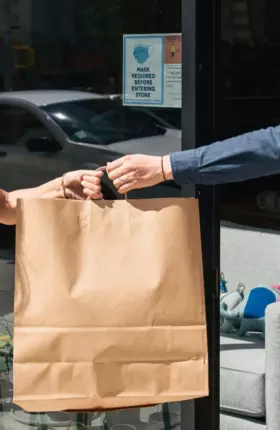As we head into the holidays, a second wave of COVID-19 is fuelling a spike of cases across North America and much of the world. Health experts and governments worldwide are warning of a “dark winter,” and the prospects for a full economic recovery in the near term are diminishing.
If there’s any good news, it’s that the shocks and continuing unknowns of the pandemic may be behind us. The world has learned a lot about the virus since March 2020. We now know that reducing super-spreader events is critical to controlling transmission. Pharmaceutical companies are developing new tests and treatments, and we have a deeper understanding of how to predict mortality across the population.
Canadian consumers and retailers have lived with the pandemic for nearly eight months. They are aware of proper health and safety precautions, and they know how to better navigate a second wave of shutdowns. Retailers have learned to operate in the “new normal” by evolving their supply chains, increasing reliance on digital channels, and ensuring the implementation of health and safety measures in their stores. While few knew what to do at the start of the pandemic, lessons learned over the past months offer hints at how to approach the future.
Given that consumer spending drives nearly 60% of Canada’s GDP, the holiday shopping season is a critical time not only for retailers but also for the national economy. Our latest research, COVID-19 in Canada: State of the Nation, examines how the current health landscape has affected consumer behaviour and trends and what this means for retailers as we approach the holiday season.
Hope for testing and vaccines as an economic panacea
Since our last report, in August, the world has made tremendous progress towards potential treatments and vaccines for COVID-19. Testing is improving, and low-cost, rapid antigen tests can now provide more effective detection of possible virus infections. The ability to test more frequently and deliver results faster enables authorities to address outbreaks and high-risk areas with surgical interventions rather than full-scale lockdowns. The potential for quick on-site testing may also soon support a more gradual easing of restrictions.
The prospects for a vaccine and effective treatments are also looking better than they were in the summer. As of the end of October 2020, according to the Biotechnology Innovation Organization and the New York Times, there were 66 vaccine candidates and 216 treatments in clinical trials, with experts predicting one or more FDA-approved vaccines in late 2020 or early 2021.
Despite the progress, consumers state that they are skeptical of both testing and vaccines. According to our research, less than a fifth of the Canadian population has been tested for COVID-19 so far, and 45% of symptomatic individuals have avoided testing because of concerns about safety precautions and the time spent in line. The expansion of testing could pose its own logistical challenges for retailers—nearly 60% of Canadians say they would avoid shopping at a retail location close to a testing centre.
Even if a vaccine becomes available by the end of this year or in 2021, its impact won’t be immediate. Half of Canadian consumers plan to wait several months after a vaccine launches to take it, 20% said they would not take a vaccine released in 2021, and 15% said they would never take a vaccine regardless of its effectiveness. This means that herd immunity, which typically requires a 60% to 70% vaccination rate across the population, could still be many months away.
While better days are on the horizon, retailers should prepare to operate in a COVID-affected world well into 2021, and possibly longer.
Consumers remain cautious and cost conscious
Our research in the spring outlined three potential GDP scenarios, ranging from a prolonged fight situation to an accelerated trajectory. So far, the early days of recovery have gone better than expected—Statistics Canada reports that by September 2020, the economy had recovered roughly two-thirds of the jobs lost in the spring, and weekly retail spending growth resumed to pre-pandemic levels. Many of the apocalyptic scenarios some economists feared at the start of the pandemic have not come to pass.
The downside is that the prospects for a double-dip or extended recession are growing more likely. While things were looking up in the summer, the second wave now sweeping the globe is adding additional pressure. New lockdowns in Europe and the potential for increased restrictions in North America are making consumers more anxious. As of October 23, Canadian consumer confidence had declined for four consecutive weeks, according to the Bloomberg Nanos Canadian Confidence Index.
The impacts on households vary by income level, but we anticipate a continuing shift to financial prudence and reduced spending over the next six months. Assistance from the Canada Emergency Response Benefit (CERB) and Employment Insurance (EI) replaced 100% of lost income throughout the spring and summer. However, more than a quarter of Canadian households still report feeling less financially secure than before the crisis, despite lost income being restored. A majority of these consumers will spend less, and even among those households that feel financially secure, half plan to spend less in the next six months (see Exhibit 1).
What consumers do with the money they leave on the sidelines depends on their financial situation. Lower-income households are spending less and focusing on improving their financial situation by building savings and/or paying off debt. As these households rely disproportionately on industries most affected by COVID, such as restaurants and the hospitality industry, they are unlikely to resume their normal spending until their employment situation has improved. Under a balanced recovery scenario, these industries will not return to pre-COVID employment levels until 2024.
Even high-income households are more cautious than before the pandemic. A quarter of these households say the large-scale deployment of a vaccine is the essential trigger for them to return to normal spending levels. Even when life returns to some semblance of normalcy, a third of consumers at all income levels say they will spend less. Among these consumers, half or more say it will take a few months to a year to resume their spending patterns, while a third say they will “potentially never” return to their pre-COVID spending patterns. This hints at a secular and longer-term shift to financial prudence, and risks triggering a long-overdue deleveraging in Canada. Such an event would challenge businesses and the economic recovery.
COVID-driven consumer behaviours continue
The second wave of the virus, combined with the potential for further restrictions and lengthened consumer financial prudence, will create significant headwinds for retailers. As a result, the retail industry must brace itself for depressed consumer spending that is likely to continue well beyond the pandemic. Smaller retailers were already hit hard by the pandemic, and we anticipate an accelerating wave of bankruptcies as emergency support programs wind down before spending recovers.
Despite the headwinds, there will be opportunities for retailers that can learn to capitalize on the fundamental market changes resulting from the crisis. Four significant Canadian consumer trends will drive retail in the coming months:
- “Stock up” behaviour will continue. Consumers are now less concerned about catching the virus while shopping than in the spring, but the “stock up” trip is here to stay. The hassle of waiting in line, especially as the weather turns colder, means consumers are shifting their in-person shopping trips to a smaller number of retailers that offer one-stop shopping. Four retail segments where consumers have reported spending the same or more since the pandemic include: groceries, clubs/warehouses, home improvement stores, and supercentres. These multipurpose aggregators should continue to benefit as consumers seek out retail destinations that enable them to buy more goods with fewer visits.
- Health, safety, and convenience remain primary drivers. While health and safety was the battleground of the Canadian retail landscape in the spring, most major retailers have implemented strict policies around masks, sanitizing, cleaning, and social distancing. The battle now is over how convenient retailers can make the shopping experience despite these health guidelines. Some leading retailers are rolling out mobile apps that enable consumers to scan products as they shop and perform self-checkout without touching store peripherals or interacting with staff. Others are enabling consumers to check wait times and occupancy numbers from outside the store to support social distancing and shorten time spent waiting in line.
- Permanent growth in e-commerce. Due to stay-at-home orders and restrictions on brick-and-mortar stores, consumers flocked to e-commerce in the spring. Despite a partial return to more normal times through the summer, consumers continue to shop online at a higher rate than they did pre-pandemic. Across all retail subsectors, online penetration has settled at a permanently higher floor, in some cases at dramatically higher levels than pre-COVID. Seventy percent of consumers say they will buy the same or more online vs. pre-pandemic across channels, with satisfaction with e-commerce purchases rising to 95%. We have witnessed years of online growth play out in a matter of months, and many consumers who were forced into the online channel are there to stay. Due to the rapid volume growth in e-commerce, many retailers are focused on improving delivery speed, increasing availability, and migrating to a sustainable cost model for online fulfillment.
- Migration from the urban core. Fuelled by financial constraints and the growth of remote work, our data suggests that the pandemic has tripled the rate of relocation relative to a typical year. We are seeing a net exodus out of dense urban areas and multifamily dwellings into suburban and rural areas and single-family homes (see Exhibit 2). With 20% to 50% of the workforce expecting to be fully or partially remote even after a vaccine launches, there appears to be a sustained shift from the urban intensification of the last several decades. As a result, retailers will need to manage costs and service levels across a more dispersed network and reassess their urban stores’ roles given sharp declines in traffic and profitability.
Preparing for the holiday hustle
While many retailers are counting on a boost from the 2020 holidays, the season will only amplify the current market trends. Retailers that look past these challenges to find opportunities will further set themselves apart from and rise above the competition. The Canadian retail landscape should expect three notable consumer trends and behaviours during the 2020 holiday season:
- Smaller group celebrations and less gift giving. The 2020 holiday season will be characterized by smaller group celebrations, enabling consumers to remain financially prudent and spend less on gifts than they did in 2019. Most Canadians plan to engage in holiday activities with five or fewer people, and less than 10% say there will be ten or more people. As a result, we anticipate a 40% decline in gift giving for others compared to 2019. One bright spot in spending potential could be millennials and Gen-Zers, who plan on cutting their spending the least and are also most likely to respond to holiday promotions.
- Reduced spending on travel and experience, relatively stable spending on goods. For a number of years, Canadian consumer trend data indicated an increase in spending on travel and gifts of experience; that trend has reversed due to the pandemic. More than half of Canadians say they will spend the same or more on consumable or durable products and less on travel and experiences than last year. The products Canadians buy will remain in line with the trends towards health and home seen throughout the pandemic (see Exhibit 3).
- Continued focus on convenience, speed, and availability. As consumers remain worried about crowds, stockouts, and delivery times, their shopping is now driven by convenience, speed, and availability. This means an earlier and extended holiday shopping period, with 40% of consumers shopping earlier or later than last year. As we expect a third of Canadians to buy more through online-only retailers and roughly 80% to buy the same or more online through traditional retailers this holiday season compared to last year’s, there will be an excessive demand for curbside pickup and click-and-collect options.
The good news is that retailers that innovate and seek advantage in the adversity will find it isn’t too late to save the holiday season. While we believe Canadian retailers are up for the challenge, agility will be critical over the next six weeks.
Retailers should ensure an efficient in-store and curbside pickup experience as convenience will be more critical than ever. In anticipation of colder weather, retailers should prepare outdoor shelter and optimize their curbside pickup routines for speed and simplicity. To meet the potential for shopping surges and unpredictable demand, they must prepare to staff up their holiday workforce to meet spikes in click-and-collect and curbside demand. They will also have to build up surge and flex-labour capacity to deploy across stores and time periods as localized surges are detected.
To reduce the risk of stockouts and to optimize fulfillment, retailers should also build flexibility into inventory positions at the stores most likely to have surges, such as the largest format stores and those with outsize click-and-collect demand. Finally, to make the most of a less-than-ideal holiday shopping season, retailers should increase the frequency with which they review short-term promotions and ensure they are allocating their investment dollars against areas of comparative strength (Gen-Zers and millennials).
Ringing in the holidays
Canada is now almost eight months into the pandemic, and several things are clear as we approach the holiday season. Regardless of income bracket, Canadian consumers are not likely to resume their normal shopping behaviours and spending patterns anytime soon. Many of the new shopping behaviours that emerged in recent months—such as acceleration of e-commerce, more cost-conscious shopping, and a search for convenient health and safety—are likely to remain the norm through the holidays and into 2021.
This holiday season will look very different from last year’s, but retailers can take control of an unfamiliar situation by building speed and flexibility into their businesses. Retailers that accept and embrace this challenge will capture outsize growth and competitive advantage in this quickly shifting environment.









